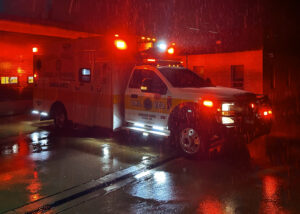OWL shares Safety Tips for Intersections
Sharing the Road with Fire & Rescue Vehicles
What to do when an emergency vehicle in response mode approaches from behind at intersections
 Navigating through busy intersections is dangerous for emergency vehicles in response mode. Intersections are the number one place where crashes involving emergency vehicles occur.
Navigating through busy intersections is dangerous for emergency vehicles in response mode. Intersections are the number one place where crashes involving emergency vehicles occur.
On the busy streets of Prince William County, it can be a challenge to move over at intersections when an emergency vehicle in response mode approaches from behind.
Several large intersections do have Opticoms. These infrared emitters are traffic signal prioritization devices. When an emergency vehicle’s lights are activated, the opticom sends a signal to override the operation of a traffic light in congested intersections. The traffic light cycle is interrupted to switch a light to green to enable traffic to clear the path for an emergency vehicle to pass safely. Opticoms help to decrease incident response times.
Opticoms do not always work, so regardless of whether an intersection has one or not, emergency vehicle operators in response mode are trained to stop at red lights, even though they have the right of way.
Here are some safety tips for what to do when an emergency vehicle in response mode approaches from behind at an intersection.
- If your light changes to green, drive safely through the intersection, then use your signal while pulling over to the nearest edge of the roadway and try to make a complete stop. Using a turn signal sends the emergency vehicle operator a message that you are aware of their presence.
- NEVER drive through a red light while trying to yield to an emergency vehicle.
- NEVER block an intersection when attempting to yield to an emergency vehicle. Instead, try to move over to the nearest edge of the road to give emergency vehicles room to maneuver through traffic.
- NEVER increase your speed to follow an emergency vehicle to get through a traffic light.
The safety of all drivers, their passengers, and emergency responders is a shared responsibility. Small actions can make a big impact, especially in emergencies. Following laws and practicing these safety tips can contribute to a safer driving environment for everyone.
The Code of Virginia Title 46.2 contains laws governing emergency vehicle operations and other motor vehicle operations.
Read our web post for more information about Virginia’s Move Over Law (§ 46.2-861.1.).
Read our “What to Do When an Emergency Vehicle Approaches” web post for more safety tips on sharing the road with emergency vehicles.